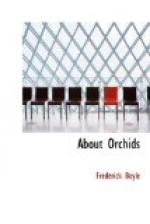The small tank on legs still remains, and I cut a few Nymphaea odorata every year. But it is mostly given up to Aponogeton distachyon—the “Cape lily.” They seed very freely in the open; and if this tank lay in the ground, long since their exquisite white flowers, so strange in shape and so powerful of scent, would have stood as thick as blades of grass upon it—such a lovely sight as was beheld in the garden of the late Mr. Harrison, at Shortlands. But being raised two feet or so, with a current of air beneath, its contents are frozen to a solid block, soil and all, again and again, each winter. That a Cape plant should survive such treatment seems incredible—contrary to all the books. But my established Aponogeton do somehow; only the seedlings perish. Here again is a useful hint, I trust. But evidently it would be better, if convenient, to take the bulbs indoors before frost sets in.
Having water thus at hand, it very soon occurred to me to make war upon the slugs by propagating their natural enemies. Those banks and borders of Saxifraga hypnoides, to which I referred formerly, exact some precaution of the kind. Much as every one who sees admires them, the slugs, no doubt, are more enthusiastic still. Therefore I do not recommend that idea, unless it be supplemented by some effective method of combating a grave disadvantage. My own may not commend itself to every one. Each spring I entrust some casual little boy with a pail; he brings it back full of frog-spawn and receives sixpence. I speculate sometimes with complacency how many thousand of healthy and industrious batrachians I have reared and turned out for the benefit of my neighbours. Enough perhaps, but certainly no more, remain to serve me—that I know because the slugs give very little trouble in spite of the most favourable circumstances. You can always find frogs in my garden by looking for them, but of the thousands hatched every year, ninety-nine per cent. must vanish. Do blackbirds and thrushes eat young frogs? They are strangely abundant with me. But those who cultivate tadpoles must look over the breeding-pond from time to time. My whole batch was devoured one year by “devils”—the larvae of Dytiscus marginalis, the Plunger beetle. I have benefited, or at least have puzzled my neighbours also by introducing to them another sort of frog. Three years ago I bought twenty-five Hyloe, the pretty green tree species, to dwell in my Odontoglossum house and exterminate the insects. Every ventilator there is covered with perforated zinc—to prevent insects getting in; but, by some means approaching the miraculous, all my Hyloe contrived to escape. Several were caught in the garden and put back, but again they found their way to the open-air; and presently my fruit-trees became vocal. So far, this is the experience of every one, probably, who has tried to keep green frogs. But in my case they survived two winters—one which everybody recollects, the most severe of this generation. My frogs sang merrily through the summer; but all in a neighbour’s garden. I am not acquainted with that family; but it is cheering to think how much innocent diversion I have provided for its members.




